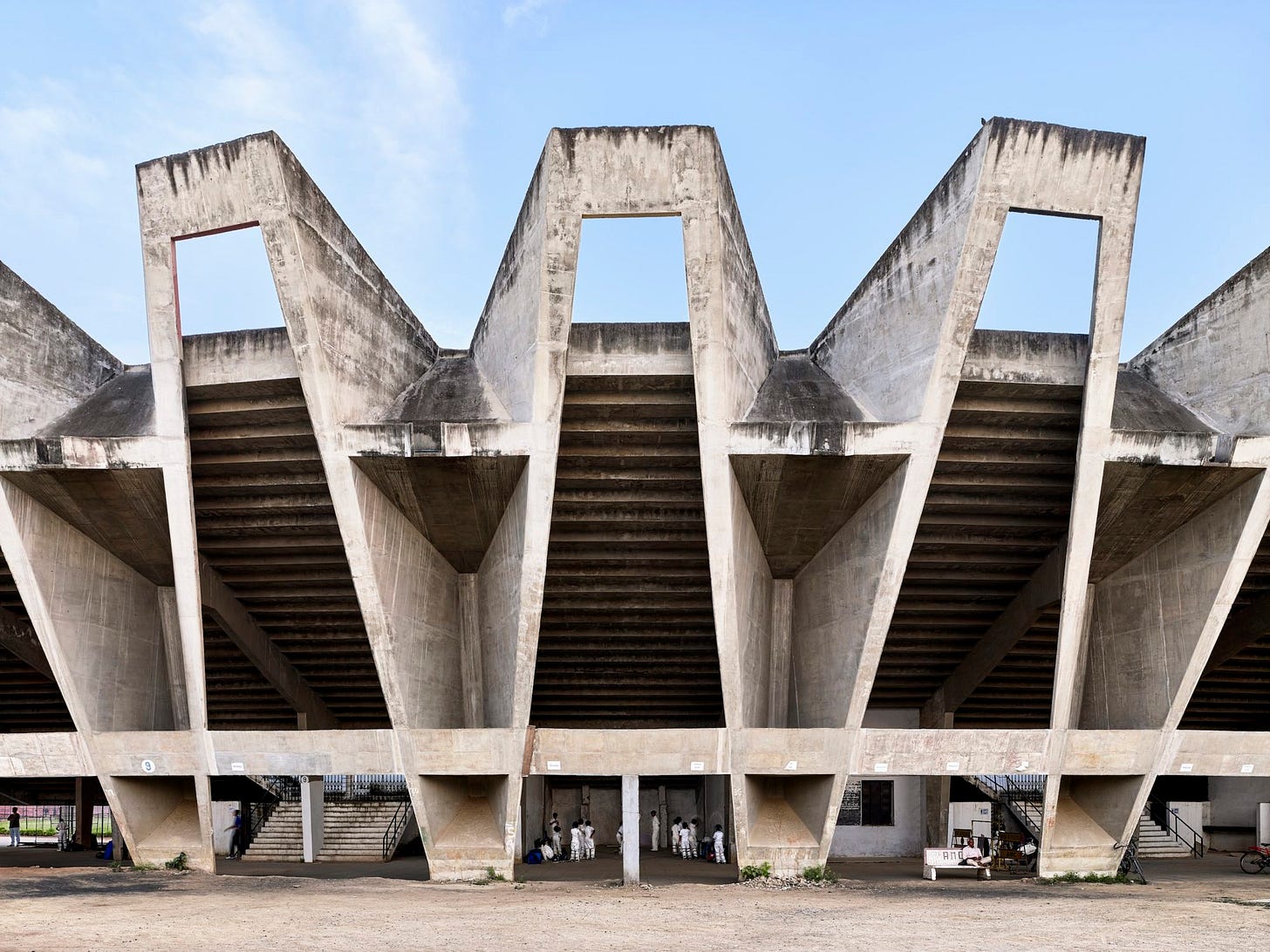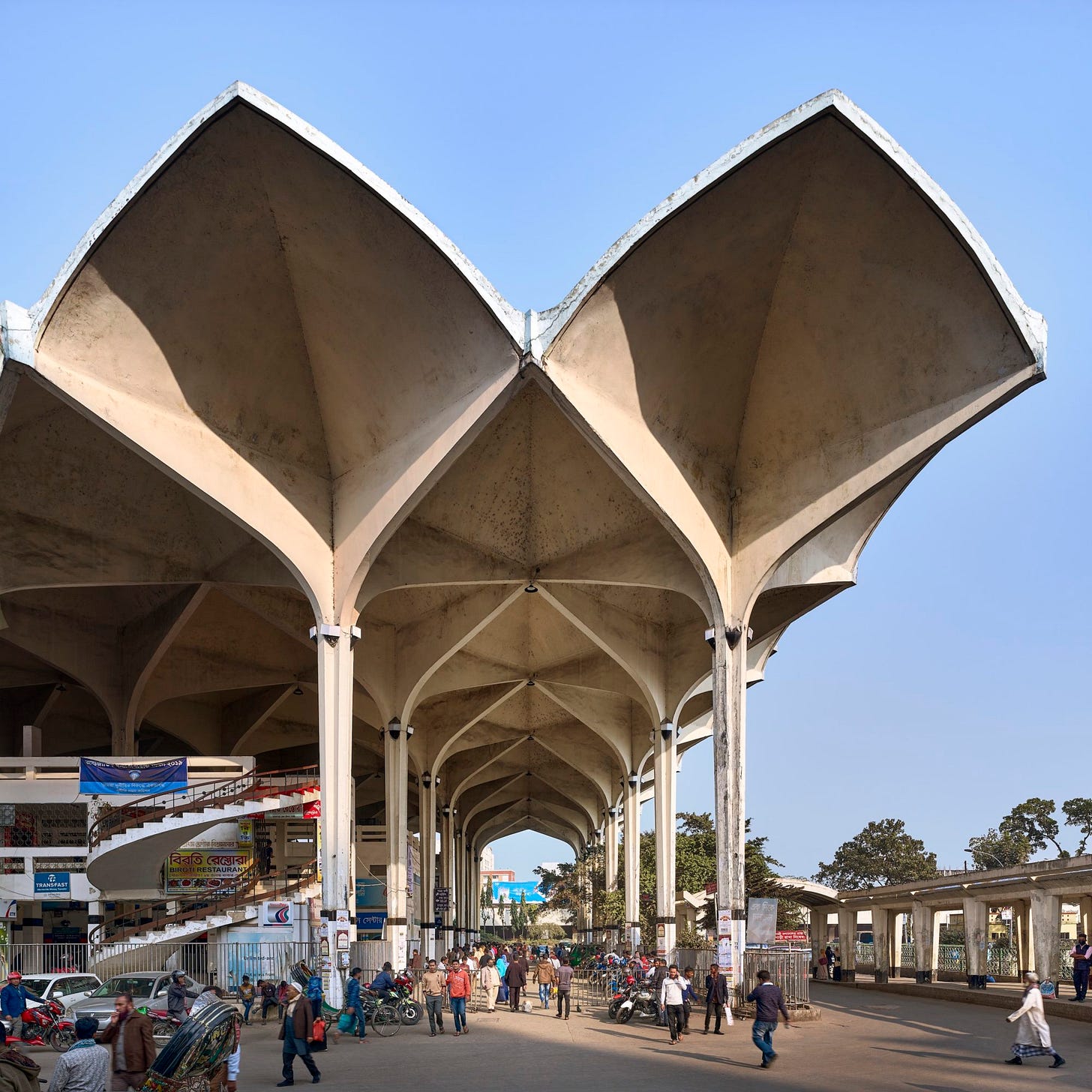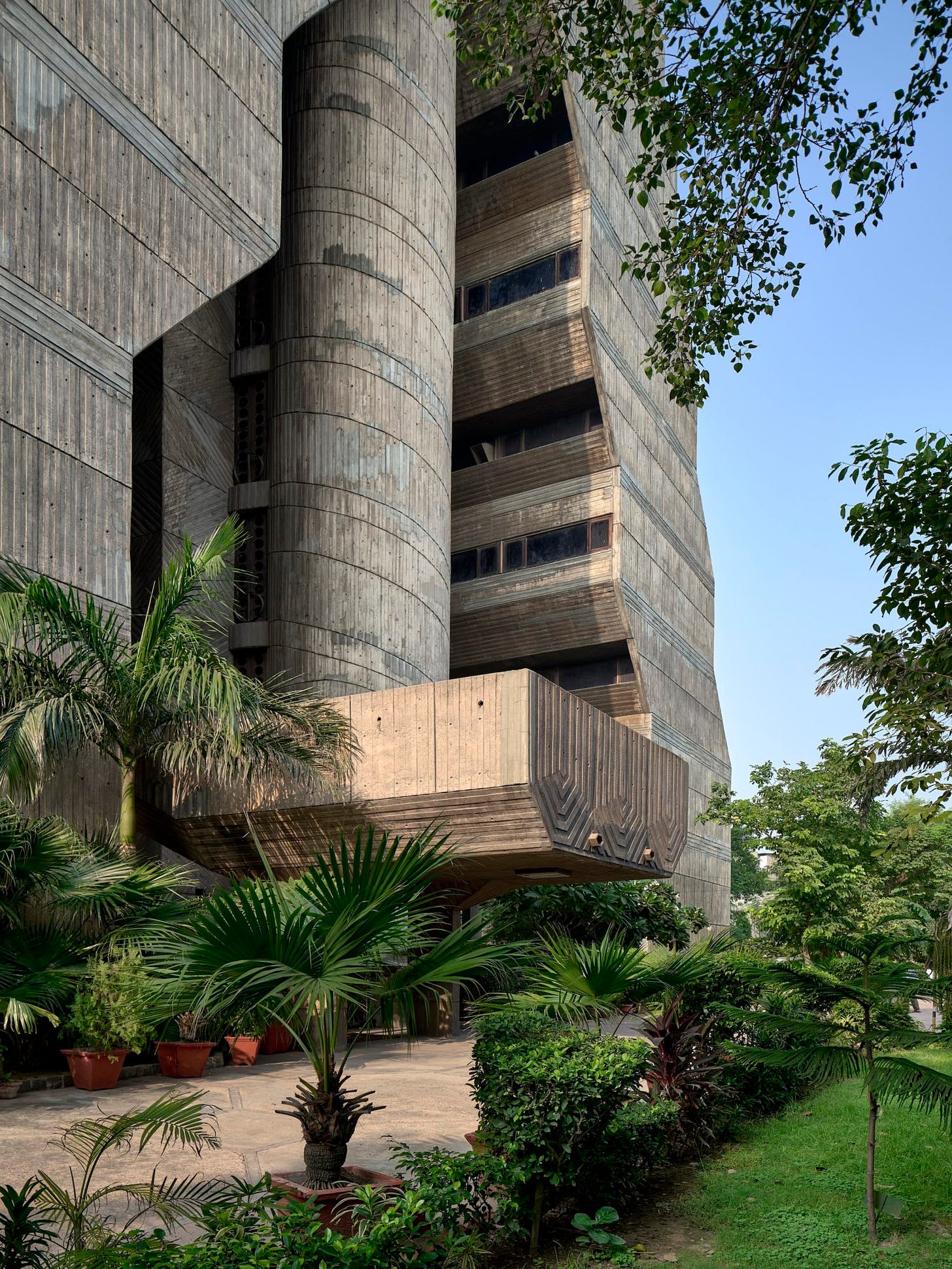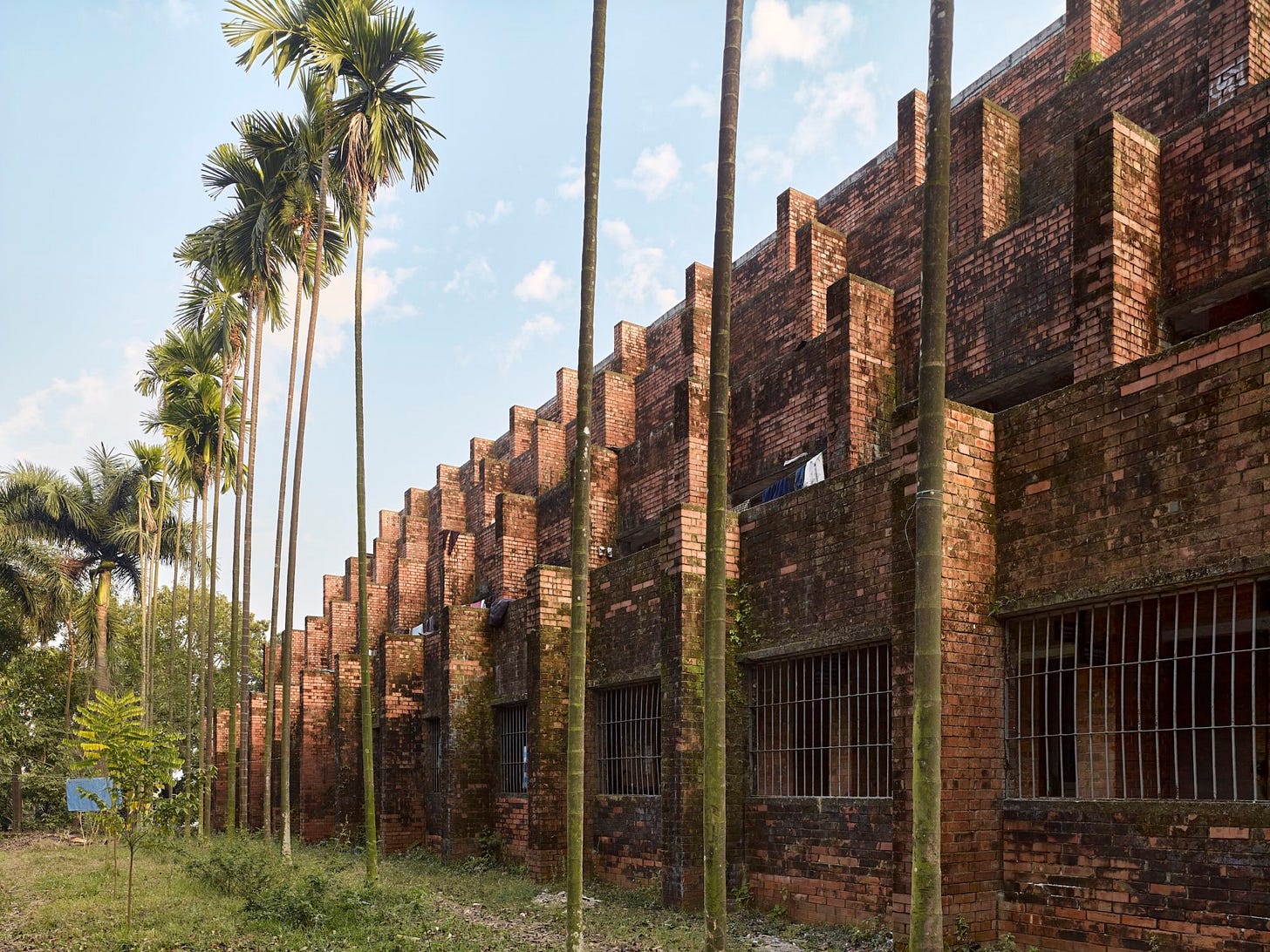By Harris Chowdhary
The following exhibition review will be published in our June/July 2022 issue, #30. The show closes this Saturday, so with an eye toward relevancy, we are sharing the piece with our readers. Peruse the full text below, or head on over to our website. To support our work and receive the issue, please consider a subscription.

Review: The Project of Independence: Architectures of Decolonization in South Asia, 1947–1985 at the Museum of Modern Art, New York, open through July 2
Full of pleasurable images and objects, MoMA’s latest architectural survey Project of Independence is arranged in categories that are not particularly meaningful. An introductory assay, “New Cities,” foregrounds the building of Chandigarh’s capitol complex, while “Templates for Living,” invokes housing’s experimental edge in the post-Partition era. Building models and archival photographs are marshaled into the remaining four sections, organized under headings closer to development NGO reportage than architecture (“Industry and Infrastructure,” “Political Spaces,” “Landscapes of Education,” and “Institution-Building”). Original photographs by Randhir Singh feature prominently across the exhibition (more on them later) as well as in an elevator bank.
Through these themes, the exhibition argues for a long overdue amendment to architectural history — a canon MoMA has itself had a major hand in packing. Unsurprisingly, this same mood of self-reflection and atonement has motivated an acquisition spree to further pad the museum’s significant holdings. With Project of Independence and its predecessors — 2019’s Toward a Concrete Utopia Architecture in Yugoslavia, 1948 – 1980 and 2015’s Latin America in Construction: Architecture 1955 – 1980— MoMA is rapidly enclosing on world architectural history, one banner exhibition at a time.
Headed up by Martino Stierli, the curatorial team (Anoma Pieris, Sean Anderson, and Evangelos Kotsioris) argues that historiographies of modern architecture in South Asia suffer from a grave misunderstanding. The phenomenon did not result, as many would argue, from a top-down transfer of technical expertise from Europe to South Asia, but rather from an encounter between this set of knowledges and autochthonous practices of building and making. The rough surfaces of Chandigarh’s great buildings bear the mark of a pre-industrial labor force unable to apply the desired smooth finish, therefore they are contextual. By contrast, details of Mahendra Raj’s structural engineering feats offer emphatic evidence of Indian prowess in matters of construction. In a different vein, postcards featuring images of cultural relics, sent by the Sri Lankan architect Minnette de Silva to Le Corbusier, posit a robust creative exchange.

But what truth is there in MoMA’s counter-narrative? After British imperial rule ended and Partition was implemented, South Asia was embroiled in strife. As newly constituted nation-states dedicated themselves to breakneck campaigns of industrialization, architects heavily contributed to shaping a progressive image of the new republics. It’s slippery, however, to call this “decolonization.” Far from the theoretical apparatus connoted by its use in the popular contemporary, “decolonization” is used here to simply describe practices taking place in the historical moment following the end of formal colonial rule. By presenting a transfer of power as systemic, political change, the show misconstrues the fumbled passing of the baton as revolution. Not surprising: Project of Independence is and was always going to be a continuation of the museum’s classic practice.
If in the past MoMA’s read of modern architecture was purely aesthetic — black-and-white photo prints distributed across the world in accordance with a stylistic doctrine that suppressed realities of construction, finance, and even experience — the museum’s politicized turn leaves just as much to be desired. What struck me about the exhibition, however, is how deep the seepage and slippage between digital media networks and hegemonic institutions have become. To address the politics of the show on political terms then feels redundant. Within the gallery, “politics” is not politics, but instead a cargo container whose movement indexes the pulse and flow of far more powerful networks that traffic pleasure, excitement, and information at speeds we may not be equipped to discuss. Here we must consider the image.
The show announces the shared ambitions of this multinational cohort (practitioners from India, Pakistan, Bangladesh, and Sri Lanka are included) with a variety of materials — pamphlets, drawings on trace paper, scale models. But as I attempted to consider a diagram of playful brick jali configurations from a publication by the British-Indian architect Laurie Baker or the shade on a gestural crayon leaf in Achyut Kanvinde’s rendering of MPKV University, I found myself distracted. Punctuating the exhibition, a series of large, color-saturated photo prints cry out to be ogled. Ultra-clear in their depiction and classicizing in composition, the images depict a handful of modernist structures as they are today, flecked with dirt and moss, in various states of use and abandon.
Singh’s photographs were commissioned by the museum and ultimately produced across South Asia during the pandemic. Murky water distends the reflection of Louis Kahn’s Dhaka Parliament (1962–82); fluorescent lights are on and nobody’s home in Shiv Nath Prasad’s Shriram Centre (1968); and the sodden concrete facade of Kuldip Singh’s National Cooperative Development Corporation Office Building (1980) rises out of a landscape. In the mechanical sense, the images suck: ink, color, attention — all channeled toward a sensual horizon. They offer themselves as portals — unframed, hung at eye level, and just the right size to transport and immerse. Both illustrative and deceptive, the photos relish in the perverse double reading of structures that appear ruined but are in fact functional. The big, hung images are ruin porn.
Emerging around 2009 and most widely circulated on Tumblr and Instagram, this genre of ultra-realistic digital photography documents the dilapidated and the abandoned. The popularity of ruin porn crested back around the time of Toward a Concrete Utopia, which took a similar approach to contemporary depictions of the architecture in its purview. Its reappearance within MoMA is inflected directly by today’s advanced media ecologies. In this sense it is useful to understand the photos as what the philosopher Vilém Flusser calls “technical images.” They are images produced from, within, and as a result of particular cybernetic structures — in this case, social media networks and their algorithms, which not only circulate the new images, but co-create them by molding and attuning the eye of a generation of producers. A decade of wading through ruin porn blogs and tags (#doom) makes Singh’s photographs instantly recognizable, legible, and codifiable to a public. It gives them context; it locates them; and it helps them speak clearly.
Something strange happens, then, when these images meet a modernist section drawing. Singh’s portraits flood the gaps between ambivalent, ambiguous technical documents with their smooth, supple, and vibrating clarity. They lob the otherwise sober media of architectural drawing and models within a specific visual lineage and, incidentally, political discourse. By providing a real reading, the photographs surround and overpower other archival representations, as drawings and documents fade into footnotes of the photographic real. The past itself, as held in the fine grain of the exhibition’s wide array of archival materials, is transformed by the new images, rewritten by the descendants of a genre of photographs that came to prominence via social-media algorithms coded to mine attention.

So if the past is being reoriented in order to sway subjects and citizens today, we might ask to what end? The 2017 demolition of Raj Rewal’s Hall of Nations (1972) in New Delhi is a touchstone for Project of Independence. The curators offer the hall — leveled to make way for icons of a new Indian state ideology — as proof that those in power in South Asia do not care for its modernist architectural heritage. But as the project arrives at MoMA through the purchase of models and drawings, its fate is perhaps just as bleak. The taxidermy of museology not only freezes the object but frames it quite exclusively. The political complexity of the building — a hall constructed for the Asia-72 international trade fair — is ignored so that it and the other projects can be stitched together as relics of a coherent “decolonial” moment at which chains were tossed to the side for a modernizing vision. Legitimized by Singh’s photographs, the projects are then pinned to the wall to desiccate for four months, accruing interest as they become the iconic representations of decolonization in South Asia. All the better if they are in MoMA’s collection.
Would we rather these projects be destroyed by India’s development-hungry elite or bled dry by MoMA’s financiers? Annihilation or taxidermy? Landfill or vault? It seems we don’t have to choose. The exhibition has decided to quiet the complexities of post-coloniality across four nations with vastly different histories in favor of an exhibition that’s easy to swallow. Further, as a new global history of architecture is written, MoMA decides who its heroes are and reminds us that most of them adored Le Corbusier.
To refuse heroics and embrace complexity within this exhibition could have opened up a timely conversation about the entirely unfinished project of decolonization to which these architects may have contributed. But mounting an exhibition that might acknowledge and even probe the failures and contradictions of this generation’s work is bad business: low foot traffic, unreliable investments.
The show lends thoughtful attention to the depiction of the construction process of Le Corbusier’s Chandigarh Secretariat Building (1952) in order to give it context, yet the networks that produced the exhibition’s loudest and most dominant components — Singh’s images — remain hidden. This feels like a missed opportunity. Rather than stage the moralistic (and mundane) claim that buildings are constructed by laborers as novel, it would have been far more interesting for MoMA to reflect on its own historiographic legacy and practice.
None of this is to say that Project of Independence lacks an argument, is hollowed out and evil, or is “bad.” Rather, I think it is important that we think and discuss the ways in which extremely powerful forms of media are employed and the effects they produce, whether intentional or not. Ultimately, it is this lack of sensitivity that troubles the exhibition’s core arguments and makes me wonder if the curatorial team were simply seduced themselves. ⬤
HARRIS CHOWDHARY is a student of architecture who just wants things to be better.
This article will be published in the June/July 2022 Issue of New York Review of Architecture, #30. Subscribe today to receive your copy.



